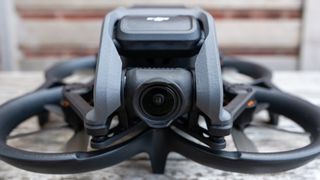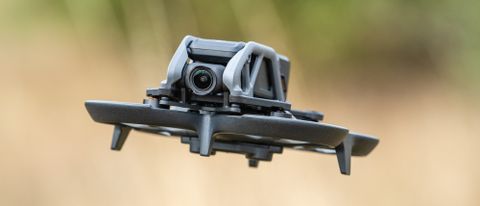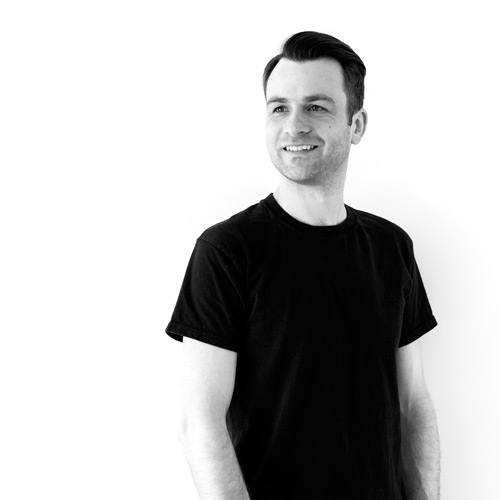Space Verdict
FPV drones are notoriously difficult to fly, but with the DJI Avata anyone can capture immersive FPV video footage in stunning 4K resolution at up to 60 fps, and it’s a whole lot of fun to fly, too.
Pros
- +
Fantastic video quality
- +
Easy to fly, even for beginners
- +
Good battery life for an FPV drone
Cons
- -
FPV goggle feed can begin to drop around 300 m
- -
Manual flight requires an additional controller
- -
Not ideal for stills photography
Why you can trust Space.com
Weight: 14.46 oz / 410 g
Dimensions: 180 x 180 x 80 mm
Battery: 2420 mAh Li-ion / up to 18 mins
Charger type: USB-C
Modes: Normal, Sport, Manual (manual only with FPV Controller 2)
Video transmission range: Up to 10 km (FCC), 2 km (CE), 6 km (SRRC)
Video resolution: 4K, 2.7K, 1080p (FHD)
Frame rates: 4K up to 60 fps / 2.7K up to 100 fps / FHD up to 100 fps (with DJI Goggles 2)
DJI may be best known for its camera drones such as the Mavic 3 and the Mavic Mini 3 Pro, but in recent years, the company has taken the plunge into the world of first-person view (FPV). The DJI Avata is DJI’s second and latest FPV drone model, following on from the curious design of the DJI FPV that was released back in early 2021.
The Avata is smaller, lighter, much more maneuverable, and sports a cinewhoop design where propeller guards are built into the drone’s airframe. The Avata is aimed at beginners with no FPV experience thanks to its easy-to-use intuitive controls, as well as seasoned FPV pilots who demand full manual control in the notoriously difficult-to-learn Acro mode.
The Avata is available as a standalone drone for those who already own compatible DJI FPV Goggles and a controller, or in two kits that include different DJI FPV Goggles and the DJI Motion Controller. The most expensive kit is the Pro-View Combo, which includes DJI’s latest DJI Goggles 2 and costs $1,388/£1,229 so it’s quite an investment, especially when you factor in the need for additional batteries.
However, what you do get is a cinewhoop FPV drone that anyone can fly confidently to capture stunning FPV video. If this drone seems a bit out of your price range, then perhaps something on our best drones round-up might better suit your budget.
DJI Avata: Design
- Robust cinewhoop design
- Take-off weight is 14.46 oz/410 g
- Smart batteries offer reasonable flight times
At 180 x 180 x 80 cm and weighing in at 14.46 oz/410 g with a battery, the Avata is slightly larger and heavier than traditional cinewhoop FPV drones, but the advantage here is accessibility.
The kits are easy to use, work perfectly out of the box, and the intelligent flight batteries remove all of the hassle and risks associated with traditional LiPo batteries. And while the batteries are rated as lasting for up to 18 minutes of flight, they typically provide around 12 minutes of flight which is still longer than traditional FPV drones. There’s even 20 GB of onboard storage alongside a microSD card slot.





The drone features a cinewhoop style design where prop guards are built into the airframe to protect the propellers and provide a degree of resilience in the case of crashes; this drone doesn’t fold up and the camera, electronics, and battery sit above the prop guards and propellers. With a drone of this design, it’s natural for pilots to be drawn into flying in complex environments and fly through tight spaces, and, from experience, we can safely say that the prop guards work well in collisions.
The controller that comes with the two kits is DJI’s Motion Controller. This requires you to tilt the controller forwards and backwards to ascend and descend, while tilting it left or right turns the drone in that direction. Acceleration is controlled using a trigger while a brake button stops the drone and leaves it in a hover if a crash appears imminent. Plus, there’s a button to switch between Normal and Sport mode, and another to take photos and to start/stop video recording.


At first glance, you’ll be forgiven for thinking it’s an abomination – it certainly takes a bit of getting used to. But once you do, it’s incredibly easy to use and intuitive, making it perfect for FPV beginners and extremely good for flying in even complex environments.
The main downside with it is that you can’t fly vertically or backwards when using it, so to do this you’d need to purchase the DJI FPV Remote Controller 2. And for expert FPV pilots who wish to fly in Manual/Acro mode, the FPV Remote is essential, but this mode is not recommended unless you’re an experienced FPV pilot with many hours of Acro flying experience.
DJI Avata: Functionality
- GPS and downward sensors
- FPV Goggles 2 provide a clear digital FPV feed
- Features augmented reality home point and Return to Home function
Traditional FPV drones have no sensor systems and certainly no GPS, but in a departure from this convention, the Avata includes these safety features when flying in Normal and Sport modes. This means that when you release the controls the drone will stop and hover, and obstacles below are detected thanks to an Infrared Sensing System and a two-camera Downward Vision System. But with no front or rear collision avoidance sensors, you still have to take great care when flying in complex environments. When flying in Manual mode, neither of these safety features are available.

GPS also brings with it Return to Home, which is automatically initiated when the battery reaches the minimum level or transmission is lost between the drone and headset. Plus, there’s Turtle mode where if the Avata is upside down after a collision it can be flipped the right way up again – a feature inherited from traditional cinewhoop drones and extremely useful. And, in the event of minor crashes, replacement propellers, the upper frame, and the propeller guard can be replaced by the user. The Avata can also be linked to DJI Refresh for added peace of mind.
The Avata isn’t a particularly fast drone with a top speed of 18 mph in Normal mode and 31 mph in Sport mode, but these speeds are perfect for flying in complex environments. To enjoy its top speed of 60 mph, you have to fly in Manual mode using the FPV Remote Controller 2 – this is a mode that requires many hours of practice using FPV simulators and cheap beginner FPV drone kits before even thinking about flying the Avata like this. It’s notoriously difficult, and even experienced pilots are prone to crashes when they push their boundaries to capture the most awe-inspiring videos.




Making FPV flight comfortable, DJI’s new ultra-low latency FPV Goggles 2 provide a clear video feed in 1080p at 100 fps, with a bitrate of 50 Mbps. Transmission distance is 10 km in the United States and 2 km in Europe, but during testing the digital signal could struggle at as close as 300 m depending on obstacles such as trees between the drone and pilot (in this situation the feed becomes highly pixelated and difficult to view).
One useful feature within the goggles is that alongside battery and flight information, an augmented reality home point makes it easy to spot where you are. Not to mention, the touch-controlled menu using a panel on the side of the goggles works exceptionally well for navigating menus and changing settings.
DJI Avata: Performance
- 48MP 1/1.7-inch CMOS sensor
- Up to 4K 60 fps video
- Normal and D-Cinelike color profiles

FPV drones are all about capturing video, so it’s here where the Avata excels. But despite this, it can capture JPEGs with its 48MP 1/1.7-inch CMOS sensor. You can take manual control of exposure or shoot in auto, but photos often feature a wonky horizon so using the camera for stills is almost pointless. This may be useful for shooting more dynamic FPV stills, but with no ability to capture Raw files results are further limited. Overall, the fixed f/2.8 lens with a fixed focus extending from 0.6 m to infinity with a 12.7 mm equivalent focal length captures excellent quality video.
The Avata is all about capturing immersive video and can capture in 4K up to 60 fps, 2.7K at up to 100 fps, and 1080p up to 100 fps with DJI Goggles 2. While with the DJI FPV Goggles V2 2.7K and 1080p video can be captured up to 120 fps – 100/120 fps is for slow motion. The maximum video bitrate is 150Mbps, and color profiles include Normal and D-Cinelike. The latter is for color grading in professional workflows, but Normal looks great straight out of camera for those who prefer simplicity.
Overall, the video quality is fantastic with fine detail present, excellent color reproduction, and impressive image stabilization. The Avata only provides mechanical stabilization on the tilt axis (vertical) with RockSteady electronic image stabilization (EIS) taking care of keeping video looking smooth with the jolty movements of the drone. It does a great job, and if you prefer even smoother video with a more stable horizon, HorizonSteady is just as effective but provides a completely different result. Both of these stabilization modes can also be turned off, but it’s much better to use EIS for smoother footage.
DJI Avata: Price
The DJI Avata is available in two kits and with the drone as a standalone, so owners of compatible controllers and goggles can use their existing accessories. This basic No RC kit includes the Avata, one Intelligent Flight Battery, a single battery charging dock, USB-C cable, a screwdriver, spare screws, and a gimbal protector, all for the cost of $629/£499.
Most people will require a full kit with a controller and DJI FPV goggles, and there are two options: the DJI Avata Pro-View Combo and the DJI Avata Fly Smart Combo. These kits offer everything in the basic No RC kit, but also include the DJI Motion Controller and a pair of goggles. The Pro-View Combo costs $1,388/£1,229 and includes the latest DJI Goggles 2 and associated accessories, while the Fly Smart Combo costs $1,168/£989 and includes the slightly older DJI FPV Goggles V2 associated accessories.
There’s also a Fly More Kit that includes two Intelligent Flight Batteries and a four-port charging hub which costs $279/£215. And, if you’d like to use a standard drone controller with the ability to fly in Normal, Sport, and Manual/Acro mode, you’ll need to purchase the DJI FPV Remote Controller 2 for $199/£139. Other accessories are also available separately including a set of three ND filters which are essential for controlling shutter speed in videos and cost $79/£59.
Should you buy the DJI Avata?
If you would like to enjoy the ability to capture immersive FPV video footage, but don’t have the skills or desire to learn how to fly a traditional FPV drone, the DJI Avata and Motion Controller is a fantastic option. It is expensive when you factor in the need to purchase the Fly More Bundle with two additional batteries that you’ll need with flight times at around the 12-minute mark per battery.
For experienced FPV drone pilots, the Avata is an excellent ready-to-fly or bind-and-fly kit depending on what compatible accessories you may or may not already have. However, to fly in Manual/Acro mode you will have to purchase the DJI FPV Remote Controller 2 separately.
Beginners who wish to be able to fly the Avata backwards and vertically will also need to consider purchasing the FPV Remote. Alternatively, those new to the hobby might want to check out our best beginner drones list instead.
If this drone isn't for you
FPV drones are all about video capture, and while traditional FPV drones would be extremely difficult to use to capture photos, the Avata does have the ability to easily capture JPEGs. This is functionality that’s better to have than not, but with single-axis mechanical stabilization (vertical) on the gimbal, if the Avata is rolling into the wind during hovering to hold its position then the horizon in photos will be at an angle, so the Avata is certainly not the ideal drone for stills photography.
If capturing high-quality aerial photos is important to you, the DJI Mavic 3 with its incredible Four Thirds camera and adjustable aperture is the best drones currently available in terms of features and image quality.
If you’re looking for a drone that’s much smaller, lighter, and ultimately more portable, the DJI Mini 3 Pro is another great alternative to consider. This palm-sized drone can capture 48MP Raw files and the camera can be rotated 90° into portrait format.
Join our Space Forums to keep talking space on the latest missions, night sky and more! And if you have a news tip, correction or comment, let us know at: community@space.com.
James is an award-winning freelance landscape and portrait photographer, as well as a highly experienced photography journalist working with some of the best photography magazines and websites with a worldwide audience. He’s also the author of The Digital Darkroom: The Definitive Guide to Photo Editing. www.jamesaphoto.co.uk

